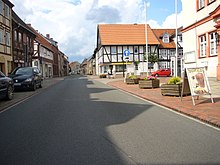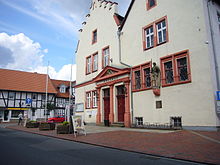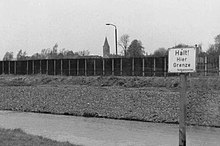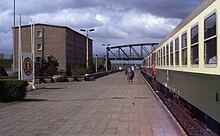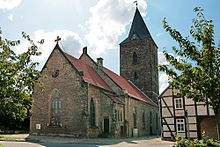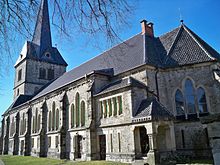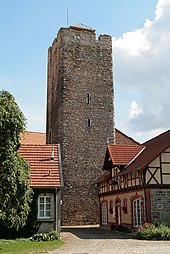Oebisfelde
|
Oebisfelde
City of Oebisfelde-Weferlingen
|
|
|---|---|
| Coordinates: 52 ° 26 ′ 0 ″ N , 10 ° 59 ′ 0 ″ E | |
| Height : | 62 m |
| Area : | 95.6 km² |
| Residents : | 4661 (Dec. 31, 2011) |
| Population density : | 49 inhabitants / km² |
| Incorporation : | January 1, 2010 |
| Postal code : | 39646 |
| Primaries : | 039002, 039057 |
Oebisfelde [ øːbɪsˈfɛldə ] is a district of the city of Oebisfelde-Weferlingen in the Börde district in Saxony-Anhalt . Since 2015 it has been officially called "City".
geography
Geographical location
Oebisfelde lies directly on the state border with Lower Saxony, formed here by the Aller , and on the transition zone from the Altmark to the Magdeburg Börde . To the east and north of Oebisfelde is the Drömling Nature Park .
Local division
The town of Oebisfelde includes the districts Stadt Oebisfelde, Bergfriede , Breitenrode , Buchhorst , Gehrendorf , Lockstedt , Niendorf , Wassensdorf and Weddendorf . The following are designated as living spaces in the village: Bleuenhorst, Frankenfelde, Hopfenhorst, Lockstedter Drömling, Siedlung, Waldfrieden, Wassensdorf Colony, Wassensdorfer Buchhorst and Weddendorfer Buchhorst. On December 31, 2011, the village of Oebisfelde had a total of 7011 inhabitants.
history
Oebisfelde was first mentioned in a document between 1014 and 1073 as Ysfelde . At that time it was still a village. In 1226 there is a report of a Wolbertus de Ousfelde , in 1263 there is talk of a castrum (castle). It is assumed that the city was planned to be built around this time. The Church of St. Catherine was also built at that time .
Later the city suffered from warlike events, in 1547 it was devastated several times in the Schmalkaldic War , during the Thirty Years War the residents often withdrew to hidden clumps in the Drömlings thicket. As a so-called Immediatstadt , Oebisfelde was directly subordinate to the Brandenburg-Prussian Duchy of Magdeburg from 1680 and was in the Holzkreis until 1807 .
In 1910 Oebisfelde had 2223 inhabitants and Kaltendorf to the north had 1641 inhabitants.
With effect from April 1, 1918, the city of Oebisfelde and the rural community of Kaltendorf were merged into a new city community "Oebisfelde-Kaltendorf". On June 5, 1923, the manor district of Oebisfelde was "incorporated" into the municipality of Oebisfelde-Kaltendorf. On May 7, 1938, the renaming of the city of Oebisfelde-Kaltendorf to "Oebisfelde" was announced in the official gazette.
Buchhorst in Drömling
Oebisfelde was located directly on the inner German border in the restricted area of the GDR, which was associated with extensive border security systems and restrictions for residents and visitors. In May 1952, the GDR closed the Büstedt –Oebisfelde border crossing to road traffic. On November 26, 1989, the border between Büstedt and Oebisfelde was reopened. With the abolition of the border in 1990, the residents were able to orient themselves towards the west, for example as workers in nearby Wolfsburg .
From 1994 to January 1, 2005, Oebisfelde was the seat of the Oebisfelde administrative community , then from 2005 to December 31, 2009 the seat of the Oebisfelde-Calvörde administrative community .
Oebisfelde has been part of the Börde district since July 1, 2007 . From 1994 to June 30, 2007 it belonged to the Ohrekreis , while for centuries it was part of the Altmark. With the dissolution of the Klötze district in the mid-1990s, Oebisfelde would have become part of the Altmark district of Salzwedel . The city council decided, however, that Oebisfelde should be incorporated into the former Ohrekreis, whose district town Haldensleben is closer to Oebisfelde.
By means of a territorial change agreement, the municipal councils of the municipalities of the city of Oebisfelde (on May 27, 2009), Bösdorf (on May 26, 2009), Eickendorf (on May 28, 2009), Etingen (on May 26, 2009), Kathendorf (on May 19 , 2009) May 2009), Rätzlingen (on May 27, 2009), Eschenrode (on May 28, 2009), Döhren (on May 28, 2009), Hödingen (on May 20, 2009), Hörsingen (on May 27, 2009), Schwanefeld (on May 25, 2009), Seggerde (on June 26, 2009), Siestedt (on May 28, 2009), Walbeck (on May 28, 2009) and the Flecken Weferlingen (on May 19, 2009) that their communities dissolved and to be united to a new city Oebisfelde-Weferlingen. This contract was approved by the county as the lower local supervisory authority and came into effect on January 1, 2010.
After implementing the unification agreement of the previously independent city of Oebisfelde, Oebisfelde, Bergfriede, Breitenrode, Buchhorst, Gehrendorf, Lockstedt, Niendorf, Wassensdorf and Weddendorf became districts of the new city of Oebisfelde-Weferlingen. For the included municipality, the local constitution according to §§ 86 ff. Municipality code of Saxony-Anhalt was introduced. The recorded community of Oebisfelde and the future districts of Oebisfelde, Bergfriede, Breitenrode, Buchhorst, Gehrendorf, Lockstedt, Niendorf, Wassensdorf and Weddendorf became the locality of Oebisfelde (since 2015 locality of the city of Oebisfelde) of the new city of Oebisfelde-Weferlingen. A local council with 20 members, including the local mayor, was formed in the commune and now locality.
Railway location
With the advent of the railroad in the second half of the 19th century, the importance of Oebisfeld grew as it became a railway junction . Until 1945, seven lines ran from Oebisfelde station : the Lehrter Bahn to Wolfsburg and Hanover , the Wittingen – Oebisfelde to Wittingen , the Salzwedel – Oebisfelde to Salzwedel , the Lehrter to Stendal and Berlin , the Oebisfelde – Magdeburg to (Neu- ) Haldensleben and Magdeburg, the Helmstedt – Oebisfelde railway and the Schandelah – Oebisfelde railway .
Towards the end of the Second World War , a freight train carrying prisoners from the Neuengamme concentration camp was parked for three days on a siding at Buchhorst station. During this time at least 53 of the doomed died and were first buried in the forest before they were buried in individual graves in a cemetery of honor.
After the end of the Second World War, three of the four cross-border routes were closed. The Lehrter Bahn to the west remained open to interzonal trains , and Oebisfelde became a border station with extensive staff.
On July 27, 1991, there was a train accident at Oebisfelde station when the Dresden – Cologne express train collided with a freight train, in which three railway employees died and 21 passengers were injured. The route to Salzwedel has been closed since September 2002, so that three more routes start from Oebisfelde.
Former transmission system for shortwave
In the summer of 1938, work began on building the Oebisfelde radio transmitter for shortwave broadcasting near Oebisfelde , which went into operation in 1942. The transmitters were housed in bunkered buildings. After the Second World War , residents of Oebisfeld were ordered to be dismantled by the occupying forces of the Soviet Union and the broadcasting buildings were blown up. Today only the well systems for the extraction of the cooling water for the water cooling of the transmitters, the pump house and the postal service house remain of the system. The substation for the power transfer to supply the station is still partially in operation.
Only a few overgrown rubble remains of the other parts of the system.
religion
Four religious communities are represented in Oebisfelde:
The Evangelical Lutheran Church of St. Catherine is of Romanesque origin and was later expanded. Your parish belongs to the Salzwedel parish of the Evangelical Church in Central Germany . The second Protestant church in Oebisfelde, the neo-Romanesque Nicolaikirche built by Conrad Wilhelm Hase in 1896, was used by the parish until 1977. Due to the lack of possibilities for the parish in the time of the GDR to support two churches structurally, and the reduced number of parishioners, it was de-dedicated. It has since been renovated and is now used for cultural events, a development association founded in 1999 supports its preservation.
The Catholic Herz-Jesu-Kirche is located on Bahnhofstrasse (renamed Karl-Marx-Strasse during the GDR era), it was built in 1906/07 and is now part of the parish “St. Hildegard ”based in Gardelegen . Its spire had to be demolished during the GDR era due to structural damage and has not been rebuilt to this day.
The Evangelical Free Church Community of Oebisfelde ( Baptists ) meets in a community room on Schillerstrasse.
The New Apostolic congregation in Oebisfelde has a church on Stendaler Strasse that was built in 2008/09. Before that, there had been a New Apostolic Church in Oebisfelde since 1925, about 100 meters from today's church. A New Apostolic congregation in Oebisfelde was mentioned as early as 1923.
politics
The honorary mayor Silke Wolf ( Die Linke ) was in office from March 30, 2008 to December 31, 2009. She was elected the first full-time mayor of the new city of Oebisfelde-Weferlingen and was in this office from January 1, 2010 to January 2017.
The local mayor is Bogumila Jacksch ( UWG ).
Local council
According to the last local election on June 7, 2009, the city council had 20 members. Due to the founding of the city of Oebisfelde-Weferlingen, the city council automatically became a local council. The turnout was 34.8%. The choice brought the following result:
| SPD | 6 seats | (27.5%) | |
| CDU | 5 seats | (25.8%) | |
| Groups of voters | 4 seats | (21.8%) | |
| The left | 4 seats | (21.5%) | |
| Individual applicants | 1 seat | (3.4%) |
In 2014 a local council with 13 members was elected, two seats remained vacant. In addition, the local mayor is a member of the local council as chairwoman.
Mayor of the former city of Oebisfelde
|
|
|
Local Mayor of Oebisfelde
- 2010–2014: Sven Groneberg
- since 2014: Bogumila Jacksch
coat of arms
The coat of arms was approved on April 6, 2000 by the Magdeburg Regional Council.
Blazon : "In green, a silver owl with a black hood and black wings turned half to the right, a silver shield on the chest with two bars of black diamonds inside."
The colors of the former city are white and green.
The coat of arms was redrawn by the Magdeburg heraldist Erika Fiedler.
Historical coat of arms
Blazon : "In silver on a green ground, a natural owl with a golden shield hung around the breast, inside two bars of black diamonds."
The coat of arms was awarded in connection with the town elevation by the landlord Gunter von Oberg. The owl was a symbol of vigilance, the breast shield with the diamonds is the family coat of arms of the Lords of Oberg .
Town twinning
A town partnership exists with the Polish Lidzbark (Lautenburg).
Culture and sights
Buildings
- Downtown with Roland
- Oebisfelde Castle ( swamp castle) with castle and local history museum
- Drömling Nature Park
- St. Catherine Church ( Romanesque origin)
- Nicolaikirche ( neo-Romanesque )
- Sacred Heart Church (built in 1906/07 based on plans by Maximilian Jagielski )
Memorials
The local cemetery contains the graves of two women and a man from Poland who are known by name, as well as two unknown Soviet people who were abducted to Germany during the Second World War and were victims of forced labor .
Sports
The largest sports club is SV Oebisfelde 1895 (formerly Lok Oebisfelde, actually Lokomotive Oebisfelde), which is particularly successful in handball. The soccer club 1. FC Oebisfelde split off from SV in 2010.
Economy and Infrastructure
Companies
There are numerous craft and retail businesses in Oebisfelde. In 2003, the Maharishi organization opened a seminar hotel with meditation facilities called the “Friedenspalast Oebisfelde” in a former barracks of the border troops .
traffic
The high-speed line Hanover-Berlin runs through the town . The trains on the high-speed line pass Oebisfelde at high speed. The Oebisfelde station is on the Berlin-Lehrter Railway and the Oebisfelde – Magdeburg railway, as well as the dismantled Oebisfelde – Salzwedel , Helmstedt – Oebisfelde , Schandelah – Oebisfelde and Wittingen – Oebisfelde railway lines . He is hourly from the regional trains of the rail means Germany Abellio towards Stendal and Wolfsburg with Alstom Coradia LINT operated trains on; In addition, regional trains run by Abellio Rail Central Germany run at least every two hours on the Magdeburg - Haldensleben - Oebisfelde - Wolfsburg route. The nearest long-distance stop is Wolfsburg Hbf . The state bus 300 has been running in the direction of Klötze - Salzwedel since 2002 as the Drömling-Express .
Oebisfelde is on federal highway 188 ( Burgdorf - Wolfsburg - Stendal - Rathenow ). Since 2011, Bundesstraße 188 has been running as a bypass road north of the town center.
There is access to the Mittelland Canal at the Bergfriede landing stage .
Personalities
sons and daughters of the town
- August Stisser (1671–1741), Lutheran theologian
- August List (1824–1890), member of the Reichstag
- Hermann Finzenhagen (1825–1914), organist, conductor and composer
- Wilhelm Siegmann (1898–1969), SS-Hauptsturmführer and concentration camp guard
- Ernst Böse (1901–1962), Member of the State Parliament of Anhalt, teacher at the Hamburg Police School
- Ernst Fricke (1912–1983), politician (SPD)
- Herbert Stass (1919–1999), actor and voice actor
- Gerd Brüdern (1920–1968), actor and director
- Erika Binz-Blanke (* 1933), graphic designer, illustrator, exhibition designer, medalist and coin designer
- Paul Held (1933–1979), chemist
- Robert Gordian (1938-2017), writer
- Ulrich Stockmann (* 1951), politician (SPD), member of the European Parliament
- Margit Müller (* 1952), world hockey champion
- Lutz Glandien (* 1954), composer
- Axel Wittke (* 1960), football player
literature
- Friedrich-Karl Sonntag, Horst Schröder: OEBISFELDE - A Chronicle . Oebisfelde 2000
- Theodor Müller: History of the city and the Oebisfelde office together with a collection of documents . Oebisfelde 1914
- Michael Frick: The Oebisfelde railway junction
- Peter Wilhelm Behrends : Description and history of the district of Oebisfelde with the epitome of several messages concerning the surrounding area and especially the Drömling . Ms. B. Eulemann, Königslutter 1798 ( digitized version ).
Web links
- Private website about Oebisfelde
- The Oebisfelde railway junction ( Memento from June 7, 2011 in the Internet Archive )
Individual evidence
- ↑ Population figures 1910 , accessed on July 30, 2011
- ↑ Administrative region of Magdeburg (Ed.): Official Gazette of the Government of Magdeburg . 1918, ZDB -ID 3766-7 , p. 184 .
- ↑ Administrative region of Magdeburg (Ed.): Official Gazette of the Government of Magdeburg . 1923, ZDB -ID 3766-7 , p. 207-208 .
- ↑ Administrative region of Magdeburg (Ed.): Official Gazette of the Government of Magdeburg . 1938, ZDB -ID 3766-7 , p. 77 .
- ↑ Heinz Pohlendt: The district Helmstedt. Walter Dorn Verlag, Bremen-Horn 1957.
- ↑ A tree as a sign of peace. In: Wolfsburger Nachrichten. Edition of December 4, 2017.
- ↑ Official Gazette of the District No. 45/2009 page 1-5 (PDF; 3.5 MB)
- ↑ Apostolic Church Niedersachsen Kdö.R., parish Wolfsburg-Fallersleben (ed.): History of the New Apostolic Church, community Wolfsburg-Fallersleben. Wolfsburg 2013, p. 2.
- ↑ 2014 election results (PDF), accessed on June 27, 2018
- ^ Website of the association ( Memento from September 17, 2013 in the Internet Archive )

